What is West Nile virus?
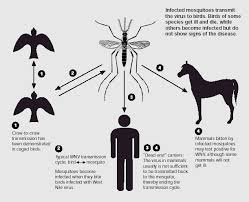
West Nile virus (WNV) is a potentially serious illness. Experts believe WNV is established as a seasonal epidemic in North America that flares up in the summer and continues into the fall. This fact sheet contains important information that can help you recognize and prevent West Nile virus.

It is a flavivirus which is common in the Middle East, West Asia and Africa, and is closely related to St. Louis encephalitis virus, which exists in the USA. West Nile virus can infect horses, bats, cats, chipmunks, skunks, squirrels, domestic rabbits, other mammals including humans, birds, and mosquitoes.

West Nile Virus can persist in humans
in some susceptible people, West Nile virus may persist in the kidneys. Much more rarely, it may persist in the brain, spinal fluid and blood, especially among those with compromised immune systems. According to the CDC, West Nile virus will only persist in people who had encephalitis during their initial illness.
How infections happen?
Humans become infected with West Nile virus through the bite of an infected mosquito. Mosquitoes bite infected birds and become infected themselves. Mosquitoes cannot become infected, experts say, when they bite other types of infected animals, because their viral load is lower birds'. After biting an infected bird, the virus circulates in the mosquito's blood for a few days, and then settles in the insect's salivary glands. When the mosquito bites an animal, bird or human, the virus can be injected into the host, where it might multiply and cause illness.
How to prevent West Nile virus?
Here are preventive measures that you and your family can take:
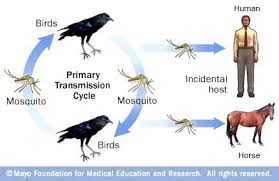
Protect yourself from mosquito bites:
•Apply insect repellent to exposed skin. Generally, the the more active ingredient a repellent contains the longer it can protect you from mosquito bites. A higher percentage of active ingredient in a repellent does not mean that your protection is better—just that it will last longer.. Choose a repellent that provides protection for the amount of time that you will be outdoors.
◦Repellents may irritate the eyes and mouth, so avoid applying repellent to the hands of children.
◦Whenever you use an insecticide or insect repellent, be sure to read and follow the manufacturer's DIRECTIONS FOR USE, as printed on the product.
◦For detailed information about using repellents, see the Insect Repellent Use and Safety questions.
•Spray clothing with repellents containing permethrin or another EPA-registered repellent since mosquitoes may bite through thin clothing. Do not apply repellents containing permethrin directly to exposed skin. Do not apply repellent to skin under your clothing.
•When weather permits, wear long-sleeved shirts and long pants whenever you are outdoors.
•Place mosquito netting over infant carriers when you are outdoors with infants.
•Consider staying indoors at dawn, dusk, and in the early evening, which are peak mosquito biting times.
•Install or repair window and door screens so that mosquitoes cannot get indoors.
Help reduce the number of mosquitoes in areas outdoors where you work or play, by draining sources of standing water. In this way, you reduce the number of places mosquitoes can lay their eggs and breed.
•At least once or twice a week, empty water from flower pots, pet food and water dishes, birdbaths, swimming pool covers, buckets, barrels, and cans.
•Check for clogged rain gutters and clean them out.
•Remove discarded tires, and other items that could collect water.
•Be sure to check for containers or trash in places that may be hard to see, such as under bushes or under your home.
What can be done to prevent outbreaks of West Nile virus?
A. Prevention and control of West Nile virus and other arboviral diseases is most effectively accomplished through integrated vector management programs. These programs should include surveillance for West Nile virus activity in mosquito vectors, birds, horses, other animals, and humans, and implementation of appropriate mosquito control measures to reduce mosquito populations when necessary. Additionally, when virus activity is detected in an area, residents should be alerted and advised to increase measures to reduce contact with mosquitoes. Details about effective prevention and control of West Nile virus can be found in CDC's Guidelines for Surveillance, Prevention, and Control.
Is there a vaccine against West Nile encephalitis?
No, but several groups are working towards developing a vaccine
Latest News about West Nile Virus
So far, this has been the worst year on record for West Nile virus infections, says the Centers for Disease Control and Prevention (CDC). 48 states have reported infections in humans, birds and/or mosquitoes. 1,993 people have been confirmed nationwide with WNV (West Nile virus) infection, of whom 87 have died. 54% (1,069) were classified as neuroinvasive disease and 924 as non-neuroinvasive disease. In neuroinvasive disease, the patient went on to develop encephalitis or meningitis.
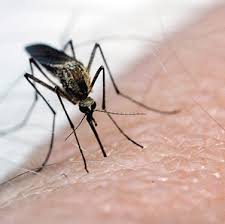
Up to September 4th, more cases have been reported this year than ever before, says the CDC. West Nile virus first infected humans in the USA in 1999.
Six states make up over 70% of all cases - Michigan, Louisiana, Oklahoma, Mississippi, South Dakota and Texas. Nearly 45% of all reported cases in the USA come from Texas.
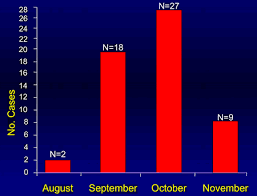
Below is a breakdown by states of West Nile virus human infections reported to ArboNET, as of September 4th, 2012 (Source: CDC):
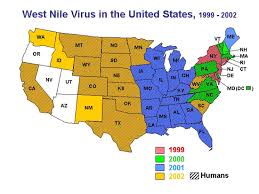
Alabama
Total cases 16. Deaths 1
Arizona
Total cases 25. Deaths 1
Arkansas
Total cases 31. Deaths 3
California
Total cases 55. Deaths 2
Colorado
Total cases 23. Deaths 0
Connecticut
Total cases 6. Deaths 0
Delaware
Total cases 1. Deaths 0
District of Columbia
Total cases 1. Deaths 1
Florida
Total cases 19. Deaths 0
Georgia
Total cases 22. Deaths 3
Idaho
Total cases 4. Deaths 0
Illinois
Total cases 48. Deaths 2
Indiana
Total cases 26. Deaths 3
Iowa
Total cases 7. Deaths 0
Kansas
Total cases 24. Deaths 1
Kentucky
Total cases 3. Deaths 0
Louisiana
Total cases 73. Deaths 6
Maryland
Total cases 14. Deaths 1
Massachusetts
Total cases 4. Deaths 0
Michigan
Total cases 95. Deaths 5
Minnesota
Total cases 41. Deaths 1
Mississippi
Total cases 113. Deaths 4
Missouri
Total cases 6. Deaths 1
Montana
Total cases 1. Deaths 0
Nebraska
Total cases 29. Deaths 1
Nevada
Total cases 0. Deaths 0
New Hampshire
Total cases 1. Deaths 0
New Jersey
Total cases 8. Deaths 0
New Mexico
Total cases 9. Deaths 0
New York
Total cases 26. Deaths 3
North Carolina
Total cases 4. Deaths 2
North Dakota
Total cases 35. Deaths 0
Ohio
Total cases 53. Deaths 1
Oklahoma
Total cases 113. Deaths 7
Oregon
Total cases 1. Deaths 0
Pennsylvania
Total cases 14. Deaths 1
South Carolina
Total cases 8. Deaths 0
South Dakota
Total cases 119. Deaths 2
Tennessee
Total cases 10. Deaths 0
Texas
Total cases 888. Deaths 35
Utah
Total cases 2. Deaths 0
Virginia
Total cases 5. Deaths 0
West Virginia
Total cases 2. Deaths 0
Wisconsin
Total cases 6. Deaths 0
Wyoming
Total cases 2. Deaths 0 Total Nationwide
Total cases 1,992. Deaths 87
Some more facts about West Nile virus
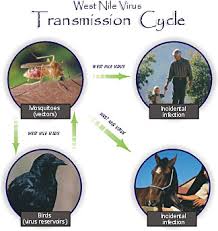
West Nile Fever occurs when an infected person develops fever, aches, a skin rash, fatigue and headache. Usually illness lasts for just a few days, but can sometimes persist for weeks, even among healthy people.
When was the USA first affected by West Nile virus? Experts are not sure. The first reported case of a human infection was in 1999.
West Nile virus was found in "overwintering" mosquitoes in New York City in 2000. What does "overwintering" mean? The Culex species of mosquito that can carry West Nile virus survived the winter in New York in the adult stage. The virus survived inside those overwintering mosquitoes that year.
Is West Nile virus' presence in North America temporary? - No, it has become permanently established in the Western Hemisphere.
Is West Nile virus human infection seasonal? - It depends on where you live. In temperate parts of the world, human infections generally occur in the late summer and early autumn, while in southern climates people can become infected throughout the year.
What is the death rate among people with severe illness caused by West Nile virus? According to the CDC, case-fatality rates range from 3% to 15%. Highest rates are found in elderly patients with severe illness. The CDC emphasizes that less than 1% of infected people develop severe illness. In the majority of human infections, there are no symptoms.